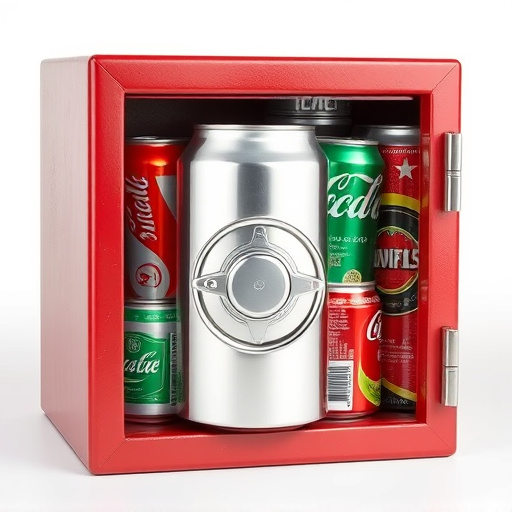"Secret Stash Containers That Look Real" offer a unique, innovative approach to safeguarding valuables by seamlessly integrating security features into everyday product packaging. These concealed safes, disguised as common household items like books, spices, or medicine bottles, provide discrete storage solutions for diverse settings, from homes to travel. Their design challenges include legal and ethical considerations, preventing misinterpretation as tampering and ensuring brand trust and consumer safety.
In today’s world, discretion is key. Unsuspecting users often seek secret stash containers that blend seamlessly into everyday life, disguised as ordinary product packaging. This article delves into the creative art of concealed safes, exploring how everyday items can serve as clandestine storage spaces. We examine design and material considerations for a realistic appearance, while navigating legal and ethical implications of these ingeniously disguised safe packages.
- Understanding Disguised Safe Packaging: Unveiling Creative Concealment
- Everyday Items as Secret Stash Containers: A Practical Approach
- Design and Material Considerations for Realistic Appearance
- Legal and Ethical Implications: Navigating Hidden Compartments
Understanding Disguised Safe Packaging: Unveiling Creative Concealment
In the world of secure storage, creativity often reigns supreme. Disguised safe packaging has emerged as a clever solution for those seeking Secret Stash Containers That Look Real. By seamlessly integrating security features into everyday product packaging, these innovative designs offer a unique approach to safeguarding valuable items. From disguised fireproof boxes hidden within common household goods to cleverly concealed gun safes masquerading as books or kitchen spices, the possibilities are endless.
This creative concealment goes beyond mere aesthetics; it leverages the trust and familiarity consumers have with everyday products. A well-designed safe that resembles a popular snack pack or a stylish coffee mug can bypass suspicion, making it an ideal choice for discreet storage. This trend not only provides peace of mind but also adds a layer of security in various settings, be it at home, in offices, or even while traveling.
Everyday Items as Secret Stash Containers: A Practical Approach
In our everyday lives, we often overlook the potential hiding spots right in front of us—these are none other than the familiar products we use regularly. Everyday items like medicine bottles, shampoo containers, or even coffee packets can serve as secret stash containers that look real, offering a practical and discrete solution for those seeking to conceal their belongings. By seamlessly integrating these items into our daily routines, they become virtually invisible repositories, ensuring your possessions remain secure while appearing harmlessly mundane.
This innovative approach leverages the abundance of common household products, providing an accessible means of protection without drawing unnecessary attention. From small trinkets to important documents, these everyday items can discreetly accommodate a variety of items, making them ideal for individuals seeking a subtle yet effective method of security in various settings.
Design and Material Considerations for Realistic Appearance
When designing secret stash containers that look real, achieving a seamless blend with everyday product packaging is paramount. Consider the visual aesthetics of common consumer goods and replicate those elements accurately. This includes matching color palettes, texturing, and even intricate printing patterns found on typical items like snacks, beverages, or household products. The goal is to create a container that doesn’t draw unnecessary attention but seamlessly integrates into its surroundings.
The choice of material plays a significant role in maintaining the realism. Opting for materials commonly used in packaging, such as sturdy cardboard, plastic with specific textures, or even glass with sealable lids, ensures your secret stash remains hidden within a seemingly ordinary item. Pay close attention to details like folds, creases, and labels to enhance authenticity. The result is a discreet storage solution that blends effortlessly into any environment, making it an ideal choice for those seeking secure yet unassuming options for their precious belongings.
Legal and Ethical Implications: Navigating Hidden Compartments
The concept of incorporating secret stash containers into everyday product packaging, while intriguing from a design perspective, raises important legal and ethical considerations. As consumers become increasingly savvy about potential hidden compartments, ensuring transparency and compliance with regulations becomes paramount. The use of such stashes could potentially be seen as tampering with products, leading to legal repercussions for manufacturers or designers involved.
Moreover, the ethical implications extend beyond the law. Concealing storage spaces within ordinary packaging may encourage activities that undermine trust in brands and could lead to serious security risks. It is crucial to strike a balance between innovative design and consumer safety, ensuring that any secret stash containers are designed responsibly, clearly indicated as such, and used only for legitimate purposes that do not compromise product integrity or consumer well-being.
In conclusion, the concept of incorporating secret stash containers within everyday product packaging offers a unique blend of creativity, practicality, and potential challenges. As demonstrated, various everyday items can be transformed into secure hiding places, providing innovative solutions for discreet storage. However, it is essential to consider the legal and ethical implications, ensuring these practices remain responsible and compliant. With careful design and material choices, achieving a realistic appearance becomes achievable, making it easier to incorporate hidden compartments seamlessly into our daily lives. This approach could revolutionize personal security measures while emphasizing the importance of discernment in product packaging design.
